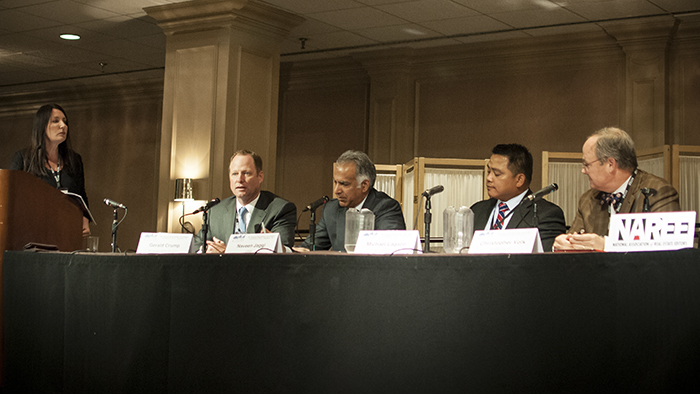NAREE Special Report: Retail Recovery Remains Delayed
Don't expect the retail sector to recover just yet. Coming off of a pre-recession to recovery period that is the longest since World War II, it won't be back to health before 2016 or even 2017, according to Naveen Jaggi.
By Suzann D. Silverman, Editorial Director

L to R: Donna Howell, Investor’s Business Daily; Gerald Crump, Weingarten Realty Investors; Naveen Jaggi, CBRE; Michael Lagazo, Sperry Van Ness; Christopher Volk, STORE Capital.
Don’t expect the retail sector to recover just yet. Coming off of a pre-recession to recovery period that is the longest since World War II, it won’t be back to health before 2016 or even 2017, according to Naveen Jaggi, senior managing director of retail services & retailer representation in the Americas region for CBRE Group Inc., during NAREE’s 48th annual Real Estate Journalism Conference. And with plenty of vacated space still to be leased up, development isn’t likely before 2017.
That said, rents are rising for Class A space in response to high demand, noted Gerald Crump, senior vice president & central region director for Weingarten Realty Investors. In the Central U.S., for instance, 20 to 25 percent increases can be achieved on renewals, with new leases signed at 8 to 15 percent above the prior tenant’s rate, he said. Even Class B space is seeing slight rental rate increases, while Class C space is managing for occupancy.
Notable in the lease-up is the polarization of the sector, Jaggi observed: Value and luxury are doing well, but there’s weakness in the middle market–a situation he expects to continue for the foreseeable future. In addition, commodity retailers are being replaced by customized concepts, according to Christopher Volk, president & CEO of STORE Capital, who specified that vacated big-box stores are leasing to new, more efficient users.
Many shareholders are pushing retail chains to divest themselves of real estate, Volk noted. But while certain categories of retailers are seeing store shutdowns–if not entire brand shutdowns–Jaggi predicted that that will not be as broad a trend as January’s announcements portended. “It won’t be as broad a tidal wave,” he said, since retailers wanting to pull back comes up against a multitude of issues, ranging from employee regulations to investor concerns to legal issues. Radio Shack offers a case in point, with its investors turning down its original plans to close 25 percent of stores.
In the electronics category, Best Buy is healthier than it was two years ago, and although it is not adding stores, none of the others can compete with it. The office supply stores are largely performing poorly, but the niche grocers continue to proliferate. In addition, noted Volk, value stores and some movie theater chains are expanding, but drug stores are not.
Whatever the brand, most new locations will be in dense, urban areas, according to Crump, although there may be some lesser movement into secondary and tertiary markets where there is less pressure to achieve high same-store sales.
For shopping centers to succeed, providing an experience is a must, declared Michael Lagazo, retail team member at Sperry Van Ness. And there will be a continuing convergence of e-commerce and brick-and-mortar retail sites. In fact, Jaggi pointed out, retailers that don’t make their website homepages the front door of their stores to succeed online, since many people–and in fact more than 70 percent of Millennials–say they prefer to shop in person.
Freestanding or lifestyle centers will likewise continue to see the greatest growth, but their anchors will see some shift over the next five years, Jaggi noted: For instance, a new anchor for 50,000- to 100,000-square-foot lifestyle centers may be a quality restaurant. Medical offices and clinics will continue to backfill spaces vacated by less successful retailers. And even grocery-anchored centers will be better balanced in the future, with less shop space devoted to the anchor, Crump said.







You must be logged in to post a comment.